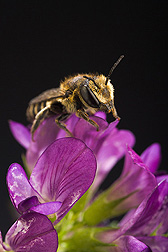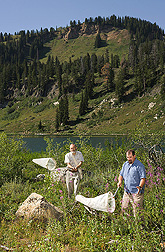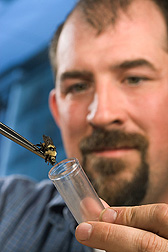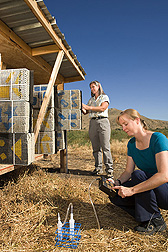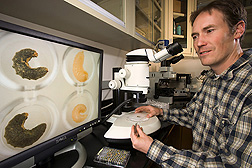Wonderful Wild Bees
How They Can Help the Harried Honey Bee
Working quietly behind the scenes, America’s wild bees help with pollination chores. Luscious berries, crunchy almonds, and many more foods that we enjoy each benefit when these mostly unheralded insects visit blossoms and inadvertently—but, for us and the plant, fortuitously—place pollen where it’s needed most.
In fact, the work of America’s wild bees might be especially needed in view of the blows being dealt to the nation’s No. 1 pollinator, the “domesticated” European honey bee, Apis mellifera.
The recent and mostly mysterious colony collapse disorder has pummeled honey bee hives, adding another burden to the bees’ already long list of woes: beetles, mites, and diseases like foulbrood and chalkbrood.
Wild and native bees are also known as “non-honey bees” because they don’t produce the sugary golden syrup. Some carry the moniker “solitary bees” because they live the single life, perhaps making their nests near other bees—in a somewhat gregarious fashion—but at the same time not surrendering their independence to the communal, ultra-socialized lifestyle of a hive, for example.
Whatever their name, these hardworking bees have always played a strong supporting role to hived honey bees.
|
|
Uncovering secrets about the lives of the nation’s wild bees commands the full attention of bee experts at a unique research facility in Logan, Utah. It’s the ARS Bee Biology and Systematics Laboratory, North America’s only scientific institution devoted exclusively to providing practical, science-based knowledge on how to domesticate, that is, manage, non-honey bees such as the alfalfa leafcutting bee, Megachile rotundata—a proficient pollinator of that forage crop; the blue orchard or orchard mason bee, Osmia lignaria—a winged worker of apple, cherry, and almond orchards; bumble bees; and others.
What’s more, the team’s unparalleled excellence as bee explorers—finders of even the most secretive of native bees—has led to a steady demand for their help in discovering and documenting the wild bees and other pollinators inhabiting ecosystems throughout the United States.
But the hunt for new six-legged talent—wild bees that could be enlisted to help A. mellifera honey bees—never really ends. Entomologist James Cane, for instance, is scoping out the skills of a “gorgeous, metallic-green bee,” Osmia aglaia. His summertime studies in Oregon and Utah show that this insect rates as a pollinator of blackberries and red raspberries.
|
|
A Berry Fine Bee, Indeed!
Cane learned of the bee from Oregon seed grower and bee enthusiast Ron von der Hellen, who told Cane about a newcomer bee—nearly a quarter-inch long—that had taken up residence in wooden nesting boards that von der Hellen keeps—near his alfalfa fields—as housing for alfalfa leafcutting bees.
For preliminary tests, Cane borrowed several hundred of the shiny bees from von der Hellen. These industrious insects, Cane learned, visited just as many red raspberry flowers, and nearly as many blackberry flowers, as did honey bees—in the same span of time.
Red raspberries and blackberries are self-pollinating, meaning that they can supply their own pollen and form fruit without needing insects to ferry pollen for them.
But bee visits made berries better.
Cane showed that red raspberry flowers visited by honey bees or the Osmia bees bore plump, well-formed berries that were 30 percent heavier than did red raspberry flowers not visited by the bees.
|
|
The Osmia bee’s work habits differ from its honey bee cousins in subtle but perhaps significant ways. For example, Cane observed that the Osmia bee “combines its outdoor errands,” always gathering both pollen and nectar in a single visit to a bloom. In contrast, honey bees “sometimes visit a flower just to sip nectar, ignoring pollen,” he says.
“We’re the first to cultivate this bee and the first to provide as much evidence of its potential as a red raspberry and blackberry pollinator,” says Cane. Now, after 5 years of study, Cane plans to give thousands of the emerald-green bees to growers and beekeepers.
The bee may someday become as respected for its berry-pollinating skill as the alfalfa leafcutting bee is for its prowess in pollinating alfalfa, a key source of nutritious, protein-rich hay for horses and cows.
Alfalfa leafcutting bees get their name from their propensity to pollinate alfalfa and their adept cutting of plant leaves into neat pieces that they use for making nests for their young, called “brood.”
Helping a Specialty Bee Protect Its Young
Like their European honey bee relatives, alfalfa leafcutting bees are vulnerable to a disease known as “chalkbrood.”
It’s caused by a fungus, Ascosphaera aggregata, that attacks bees when they are still larvae—the wormlike young that emerge from eggs that are laid by the female bee.
“Even though the term ‘brood’ includes all the immature stages of a bee’s life, chalkbrood only seems to infect the larvae,” notes Rosalind James, research leader at Logan and an international authority on this bee disease.
Healthy larvae form small cocoons, become pupae, then emerge as young bees. But larvae attacked by chalkbrood typically turn into blackened corpses or, less often, ones that are chalk white or mottled black and white.
“Chalkbrood disease is such a huge problem for alfalfa leafcutting bees in the United States that growers who farm alfalfa for seed have to buy at least 50 percent of their alfalfa leafcutting bees every year from Canada, where the disease is less prevalent,” James says.
|
|
Working with alfalfa-seed growers in Washington, James looked at some of the techniques they use to disinfect nesting boards and to kill fungal spores. Made of wood or polystyrene, nesting boards have holes drilled in them for bees to use to build their leafy nests. “Even when the boards were properly disinfected,” James explains, “that wasn’t enough to significantly decrease the number of larvae killed by chalkbrood.
“Spores are spread accidentally when farmers remove the nests to disinfect the boards and to store nests, with the larvae still inside, for the winter,” she says.
Spraying an iprodione fungicide on the nests after they’re taken out of the nesting boards “reduced chalkbrood levels by up to 50 percent—with no measurable loss of young,” she reports.
Now, James and her crew of technicians are looking for fungicides that may be even more effective in killing the spores.
What Makes Home Appeal to Bees?
Besides helping bees keep their homes free of chalkbrood, the Utah scientists are tackling another housing issue: how to entice bees to live in nesting boards strategically placed in or near berry farms, cherry or almond orchards, or anywhere else growers want the bees to work. For example, if more were known about chemical cues that female bees respond to when searching for a place to make their nests, tomorrow’s growers might be able to use lab-made versions of those natural compounds to attract bees.
Entomologist Theresa Pitts-Singer at Logan and colleague Jim Buckner of the ARS Insect Genetics and Biochemistry Research Unit, Fargo, North Dakota, are using gas chromatography to learn more about the natural chemicals in nests of solitary bees. And they’re using scanning and transmission electron microscopes to find the source of a nest-marking chemical that female bees secrete. “It may be the Dufour’s gland, part of their sting apparatus,” says Pitts-Singer, “but we don’t know for certain.
“Perhaps each female has her own signature scent that enables her to differentiate her nesting-board home from the hundreds, if not thousands, of others that look just like hers.”
In an experiment with blue orchard bees, Pitts-Singer, and colleagues—including Christelle Guédot, now a post-doc with ARS at Wapato, Washington, and Buckner—used slender glass tubes, about the same width and length as a hole drilled in a typical nesting board, to spy on female bees that were using the glassware as a home.
“Nest-making female bees dragged their abdomens along the tubes when they were on their way out,” says Pitts-Singer. “Sometimes they did spins and spirals. We know they smear a liquid on the tube, but we don’t know where they secrete it from or what its chemical composition is.”
To learn more about how bees recognize their nests, Pitts-Singer’s team cut the glass tubes into three sections, then replaced the outer section, the middle section, or both, with clean tubing.
Female bees returning to the altered homes “became hesitant and confused,” Pitts-Singer says. “We think this indicates that the missing sections had some olfactory cue—or cues—that the females had used for recognizing their nests.”
Analysis of the compounds in the tubes and on the bees’ bodies provided some of the first-ever evidence about the presence of these compounds plus information about their chemical makeup.
Whether deciphering these cues to make new nests more alluring, combating bees’ worst diseases, or seeking specialty bees, the Logan lab is abuzz with discoveries about how to skillfully manage our wild bees.—By Marcia Wood, Agricultural Research Service Information Staff.
This research is part of Crop Production, an ARS national program (#305) described on the World Wide Web at www.nps.ars.usda.gov.
To reach scientists mentioned in this story, contact Marcia Wood, USDA-ARS Information Staff, 5601 Sunnyside Ave., Beltsville, MD 20705-5129; phone (301) 504-1662, fax (301) 504-1641.
"Wonderful Wild Bees" was published in the February 2008 issue of Agricultural Research magazine.







